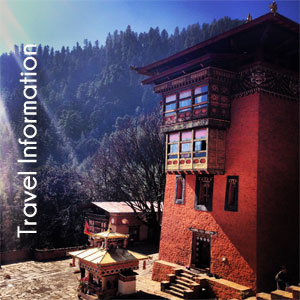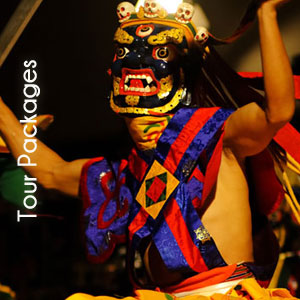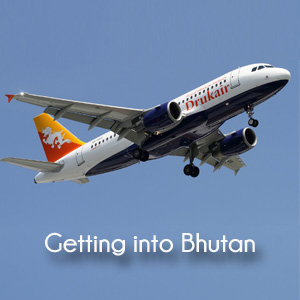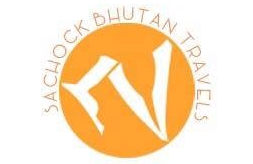Day 01: Arrive at Paro, Paro –Thimphu
Fly into Paro by Druk Air, Bhutan’s National Airline. The great snowcapped peaks of the inner Himalayas rise up to the heavens can be seen during clear weather. As the plane approaches Bhutan, if you look down farmhouses as dots on the hillsides can be seen.
As the aircraft enters the Paro valley, you will see Paro Dzong on the hillside overlooking the Paro Chu (river), with Ta Dzong, formerly a watchtower and now the National Museum, above it.
You will be received by the representative of Sachock Bhutan Travels, who will be assisting you throughout your tour.
After the refreshment, visit the Ta Dzong, built in the 17th century as a watchtower for the Paro Dzong. This dzong was converted into the National museum in 1967 and is filled with antique thankha paintings, textiles, weapons and armor. Drive to see Rinpung Dzong, built in 1645 to defend the valley against Tibetan invaders. The Dzong is now being used as an administration center and school for monks. Walk down to Rimpung Bridge ( Traditonal Bridge), oldest bridge in Bhutan.
Drive to Thimphu, the capital of Bhutan. Drive to the Changangkha temple – temple of Chenrigzig known as Buddha of Compassion and offer butter lamps. Drive to see the Takin Zoo, which houses the national animal the Takin that is only found in Bhutan. Drive to Sangaygang to get a bird’s eye view of the Thimphu valley in the evening. Dinner and overnight at hotel in Thimphu.
Day 02: Thimphu Sightseeing ,Thimphu –Punakha-Wangdue
Thimphu sightseeing includes visits to the following:
The National Library, housing an extensive collection of priceless Buddhist manuscripts. The National Institute of Traditional Medicine (outside only), where Bhutan’s famed traditional herbal medicines are compounded and dispensed.
The Institute for Zorig Chusum (commonly known as the Painting School) where students undergo a 6-year training course in Bhutan’s 13 traditional arts and crafts.
The National Folk Heritage Museum to get an insight into the typical Bhutanese way of life.
The Textile Museum to get an understanding of the beautiful hand woven Bhutanese textiles.
If the time permits, visit Tashichhodzong, “the fortress of the glorious religion”. This is the center of government and religion, site of the monarch’s throne room and seat of the Je Khenpo or Chief Abbot. Built in 1641 by the political and religious unifier of Bhutan, Shabdrung Ngawang Namgyal, it was reconstructed in the 1960s in traditional Bhutanese manner, without nails or architectural plans.
In the late afternoon, drive to Punakha (2 ½ hrs) via the Dochula pass. An hour’s drive from Thimphu will take you to this pass (3140 m) where one can have a superb view of the Eastern Himalayas on a clear day with a powerful binocular telescope. Visit the beautiful 108 chortens built on the hill by Her Majesty Ashi Dorji Wangmo for the security and well being of His Majesty the King of Bhutan.
Drive onto Punakha, the old capital of Bhutan and presently the winter residence of the central monk body. Visit the Punakha Dzong, located on the island of the Pho-Chu (male) river and the Mochu (female) river. Visit the Dho Jha Gha Lam Temple.
In the evening, walk through the Metshina Village and take a 20-minute walk through the rice fields to the Devine Madman’s Monastery-Chhimi Lhakhang, famously known for its fertility shrine, where couples unable to concieve come here for blessing. Overnight at hotel in Wangdue.
Day 03: Wangdue – Trongsa -Bumthang
Drive to Trongsa via Pele la pass at an altitude of 3,150 metres, a wonderful opportunity for photographs. Stop over at Trongsa to visit Trongsa Dzong, which is the most impressive dzong in Bhutan. Built in 1644 by the Shabdrung, the dzong is an architectural masterpiece.
Drive to Bumthang, this is one of the most spectacular valleys in Bhutan and also the heartland of Buddhism. Here the great teachers meditated and left in their wake many sacred grounds. The Guru and his lineage of Tertons, treasure finders, have led to the sprouting of many temples in the valley. Visit Yatha Weaving Center, a cooperative of the National Women Association of Bhutan where the women of the region sell their textiles and Yatha specialty.
Check into hotel and overnight in Bumthang.
Day 04: Bumthang Sightseeing
The sightseeing in Bumthang includes the visits to the following:
Jambay Lhakhang, built in the 7th century by the King Songtsen Goempo of Tibet. In his effort to propagate Buddhism he had a plan to build a total of 108 temples in Tibet and neighboring kingdoms.
Chakhar Lhakhang. Besides the main road, a short distance beyond Jambay Temple is Chakhar (Iron Castle) Lhakhang. Although it is easy to mistake it for a house and drive right by, this is an interesting temple and is worth a short visit. It is one of the 108 monasteries built by him to subdue evil spirits in the Himalayan region.
Kujey Lhakhang (Kujey means, “Body imprint”). The temple to the right is the oldest and was built by Minjur Tempa in 1652. It was built around the cave in which Guru Rimpoche meditated and left his body imprint.
Tamshing Lhakhang. This temple is also known as Tamshing Lhendrup Chholing (Temple of the Good Message).
Jakar Dzong, “castle of the white bird”. According to legend, when the lamas assembled in about 1549 to select a site for a monastery, a big white bird rose suddenly in the air and settled on a spur of a hill. This was interpreted as an important omen, and the hill was chosen as the site for a monastery and for Jakar Dzong. The fortress is now used as an administrative center of the valley and summer residence of Trongsa monks.
In the evening stroll around the beautiful landscape of the Bumthang valley. Dinner and overnight at hotel in Bumthang.
Day 05: Bumthang -Gangtay -Wangdue
After early breakfast, drive to Gangtey Gompa with picnic lunch en route. Visit Gangtey Gompa, which now houses one of the only Nyingmapa monastery in Bhutan. The valley is also the winter home to the rare black-necked cranes (Grus Nicorocolis), which migrate, from remote parts of Tibet, China and Siberia to winter in this valley. Drive to Wangdue for overnight stay.
Day 06: Wangdue – Paro
Visit Wangdue Dzong, situated on a ridge overlooking a river junction. In the 17th century, Wangdue played a critical role in unifying the western, central and southern regions of the country. Also visit the local market.
Drive back to Paro, driving through the idyllic countryside, dotted with villages and paddy fields, crossing rivers and natural forests to Paro, visiting Simtokha Dzong en route. This dzong, built in 1627, is the oldest in Bhutan. It now houses the Institute for Language and Culture Studies.
In the evening, free to relax or stroll around Paro town, do shopping, etc.Overnight at hotel in Paro.
Day 07: Departure from Paro
In the morning, your tour guide from Sachock Bhutan Travels will escort you to the Paro airport for your onward destinations.

Bhutan Travel Info
Bhutan Travel tips, Daily Tourist Tariff, Bhutan Visa Information, Tour payment regarding your tour booking to Bhutan. Click on the link below to know more.
Learn more >>

Tour Packages
Travel to Bhutan with Sachock Bhutan Travels. We, at Sachock offers Cultural tours, Trekking Tours including the World's toughest Trek Snowmen Trek and colorful Festival tours of Bhutan.
Learn more >>

Getting into Bhutan
Travelling to Bhutan can be accessible by Air, to Paro(the only international airport in Bhutan connecting with Indian Cities, Nepal, Bangaldesh, Thailand & Singapore) & Road through Southern border towns of Phuentsholing, Gelephug and Samdrup Jongkhar.
Learn more >>

Sachock Bhutan Travels, P.O Box No: 1304, Karma Khangzang, Thimphu : Bhutan
Phone # (+975) 77177717 / 77210443 : Tele-Fax (+975) 2 333 881
Email: [email protected] / www.SachockBhutanTravels.com
Sachock Bhutan Travels, Copyright © 2024. All Rights Reserved. Website Design & Hosted by Wangyel-Studio






